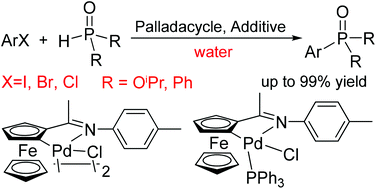Palladacycle-catalyzed phosphonation of aryl halides in neat water†
Abstract
An efficient and generally applicable protocol for the palladacycle-catalyzed arylation of

* Corresponding authors
a
The College of Chemistry and Molecular Engineering, Henan Key Laboratory of Chemical Biology and Organic Chemistry, Key Laboratory of Applied Chemistry of Henan Universities, Zhengzhou University, Zhengzhou 450052, People's Republic of China
E-mail:
yangf@zzu.edu.cn, wyj@zzu.edu.cn
Fax: +86-371-67979408
An efficient and generally applicable protocol for the palladacycle-catalyzed arylation of

 Please wait while we load your content...
Something went wrong. Try again?
Please wait while we load your content...
Something went wrong. Try again?
K. Xu, F. Yang, G. Zhang and Y. Wu, Green Chem., 2013, 15, 1055 DOI: 10.1039/C3GC00030C
To request permission to reproduce material from this article, please go to the Copyright Clearance Center request page.
If you are an author contributing to an RSC publication, you do not need to request permission provided correct acknowledgement is given.
If you are the author of this article, you do not need to request permission to reproduce figures and diagrams provided correct acknowledgement is given. If you want to reproduce the whole article in a third-party publication (excluding your thesis/dissertation for which permission is not required) please go to the Copyright Clearance Center request page.
Read more about how to correctly acknowledge RSC content.
 Fetching data from CrossRef.
Fetching data from CrossRef.
This may take some time to load.
Loading related content
